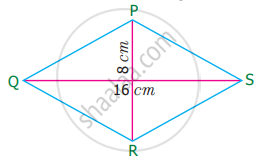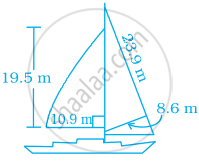Advertisements
Advertisements
Question
Find the missing value.
| Diagonal (d1) | Diagonal (d2) | Area |
| 19 cm | 16 cm |
Solution
Given diagonal d1 = 19 cm, d2 = 16 cm
Area of the rhombus = `1/2` (d1 × d2) sq.units
= `1/2` × 19 × 16
= 152 cm2
Tabulating the results we have
| Diagonal (d1) | Diagonal (d2) | Area |
| 19 cm | 16 cm | 152 sq.cm |
APPEARS IN
RELATED QUESTIONS
The perimeter of a rhombus is 40 cm. If one diagonal is 16 cm; find:
- It's other diagonal
- area
Find the area of a rhombus whose diagonals are of lengths 10 cm and 8.2 cm.
Find the area of rhombus PQRS shown in the following figure.
Find the missing value.
| Diagonal (d1) | Diagonal (d2) | Area |
| 26 m | 468 sq.m |
Find the missing value.
| Diagonal (d1) | Diagonal (d2) | Area |
| 12 mm | 180 sq.mm |
The area of the rhombus with side 4 cm and height 3 cm is
The area of the rhombus when both diagonals measuring 8 cm is
The figure ABCD is a quadrilateral in which AB = CD and BC = AD. Its area is ______.

Area of a rhombus = `1/2` product of ______.
Most of the sailboats have two sails, the jib and the mainsail. Assume that the sails are triangles. Find the total area sail of the sailboats to the nearest tenth.

